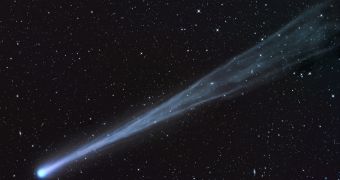According to the conclusions of a new study presented at the annual meeting of the American Geophysical Union (AGU), held in San Francisco, it would appear that astronomers can finally say for certain that Comet C/2012 S1, or Comet ISON, is dead.
The announcement was made at the AGU meeting on December 11, by researcher Karl Battams, who is a comet expert at the US Naval Research Laboratory (NRL), in Washington, DC. “At this point, it seems like there's nothing left. Comet ISON is dead; its memory will live on,” he told attendants.
ISON was a sungrazing comet that reached its perihelion, or point of closest approach to the Sun, on November 28, 2013. The entire astronomical community was holding its breath to see whether or not the icy dust ball would survive its fiery rendezvous with the star.
Though initial signs suggested that at least some parts of the comet survived perihelion, the most recent data suggest that no discernible core remains from the once-proud comet. It is possible that some debris did endure, and is currently on a path that will take it out of the solar system. It is unlikely any remnants will survive the trip, Space reports.
A number of spacecraft, including the NASA Solar Terrestrial Relations Observatory (STEREO) and Solar Dynamics Observatory (SDO), and the joint NASA/European Space Agency Solar and Heliospheric Observatory (SOHO) watched Comet ISON as it approached the Sun last month.
Since data from these telescopes were inconclusive as of early December, astronomers waited for some observation time to clear up on the NASA/ESA Hubble Space Telescope to confirm the comet's demise.
Officials at NASA confirmed that ISON had been disintegrated, on December 3. During perihelion, the comet was just 1,165,000 kilometers (724,000 miles) above the surface of the Sun.
“Never one to follow convention, ISON lived a dynamic and unpredictable life, alternating between periods of quiet reflection and violent outburst. However, its toughened exterior belied a complex and delicate inner working that only now we are just beginning to understand,” astrophysicist Karl Battams commented at the time on NASA's Comet ISON Observing Campaign website.
The main reason why astronomers were expecting to see Comet ISON destroyed was that its core was probably less than 600 meters (1,970 feet) in diameter. Comets of this size rarely survive their perihelions.
“NASA is going to try to look for it with Hubble, and I've heard that Spitzer and Chandra may be attempting observations as well. That really is sort of a recovery mission, but I don't know if we're going to get any success with those,” Battams concludes.

 14 DAY TRIAL //
14 DAY TRIAL //